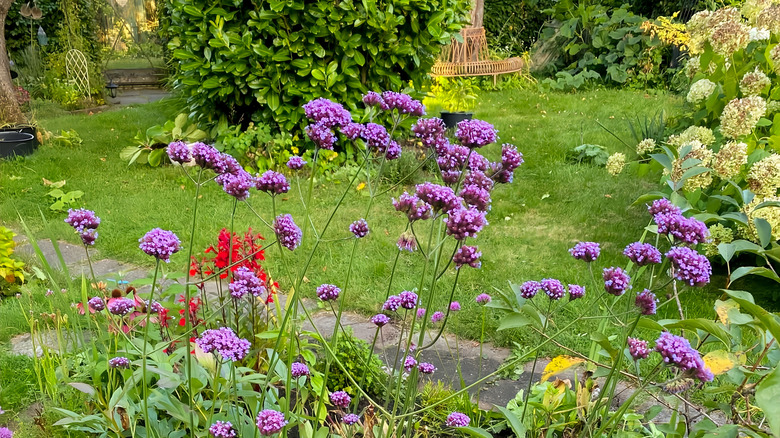How To Divide Perennial Verbena In Fall To Give Yourself More Plants For Free
Everyone should have a gardening to-do list for fall – cut back perennials, refresh mulch, and do a little strategic deadheading, all before the first frost hits. One important fall task you won't want to skip is dividing garden herbs that have outgrown their space. Among these plants is perennial verbena, known for its clusters of delicate purple flowers and sprawling, ground-hugging habit that fills garden beds and containers with color. Over time, these plants may become a little crowded or woody at the center, meaning it's time to divide and rejuvenate them for the following year.
To get started, focus on choosing the right candidate for division. Mature plants that have been growing relatively unchecked for a few years tend to be the best option, especially if their center looks woody or sparse. Dividing perennial verbena rejuvenates plants by encouraging fresh, healthy root growth.
Start by loosening the root ball with a shovel or fork, carefully lifting the plant out of the ground. You'll want to ensure that the root ball is intact as you lift, keeping as much of the root system protected in the process. Shake off excess soil to expose the roots and use your hand or a clean knife to divide the clump into smaller sections. Each section of your root ball should consist of healthy — preferably new — roots and a few stems. Replant the new divisions right away in rich, well-draining soil, and water thoroughly to help the plants establish before the temperature drops. Above-ground growth may be slow to start, but the roots will continue developing throughout winter.
The benefits of dividing your verbena (& long-term care)
Dividing perennial verbena isn't just about multiplying your plants — it's about keeping your garden balanced and healthy year-round. Although verbena is on the list of low-maintenance perennials, that doesn't mean it won't benefit from a bit of seasonal care. When a plant has been growing for several years, it may start to show telltale signs of fatigue. The center may become woody, the flowers can start to thin out, and the overall spread may start to slow. Additionally, depending on the species, an overgrown verbena plant can start to crowd out other flowering perennials, making your garden feel unbalanced.
Dividing the plant into smaller sections ensures it has the space and energy that is necessary for healthy growth. Each division should have plenty of room to spread out and take in more nutrients, resulting in fuller foliage and brighter flowers once spring arrives. With a little effort, bare spots become opportunities to expand your beds without purchasing new plants.
After planting, a little fall care can make a significant difference. For the first few weeks, you will want to keep the soil lightly moist to allow the roots time to establish before winter sets in. Follow it up with a protective layer of mulch to insulate against cold temperatures and lock in moisture. Avoid fertilizing until the spring, when plants start to put out new growth. During the winter, your verbena will focus on root development, preparing to bloom with vibrant purple flowers in spring.

